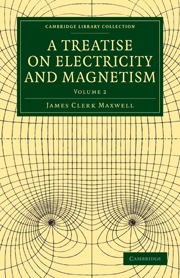Book contents
- Frontmatter
- Contents
- PART III MAGNETISM
- PART IV ELECTROMAGNETISM
- CHAPTER I ELECTROMAGNETIC FORCE
- CHAPTER II MUTUAL ACTION OF ELECTRIC CURRENTS
- CHAPTER III INDUCTION OF ELECTRIC CURRENTS
- CHAPTER IV INDUCTION OF A CURRENT ON ITSELF
- CHAPTER V GENERAL EQUATIONS OF DYNAMICS
- CHAPTER VI APPLICATION OF DYNAMICS TO ELECTROMAGNETISM
- CHAPTER VII ELECTROKINETICS
- CHAPTER VIII EXPLORATION OF THE FIELD BY MEANS OF THE SECONDARY CIRCUIT
- CHAPTER IX GENERAL EQUATIONS
- CHAPTER X DIMENSIONS OF ELECTRIC UNITS
- CHAPTER XI ENERGY AND STRESS
- CHAPTER XII CURRENT-SHEETS
- CHAPTER XIII PARALLEL CURRENTS
- CHAPTER XIV CIRCULAR CURRENTS
- CHAPTER XV ELECTROMAGNETIC INSTRUMENTS
- CHAPTER XVI ELECTROMAGNETIC OBSERVATIONS
- CHAPTER XVII ELECTRICAL MEASUREMENT OF COEFFICIENTS OF INDUCTION
- CHAPTER XVIII DETERMINATION OF RESISTANCE IN ELECTROMAGNETIC MEASURE
- CHAPTER XIX COMPARISON OF ELECTROSTATIC WITH ELECTROMAGNETIC UNITS
- CHAPTER XX ELECTROMAGNETIC THEORY OF LIGHT
- CHAPTER XXI MAGNETIC ACTION ON LIGHT
- CHAPTER XXII ELECTRIC THEORY OF MAGNETISM
- CHAPTER XXIII THEORIES OF ACTION AT A DISTANCE
- INDEX
- Plate section
CHAPTER XVI - ELECTROMAGNETIC OBSERVATIONS
Published online by Cambridge University Press: 05 July 2011
- Frontmatter
- Contents
- PART III MAGNETISM
- PART IV ELECTROMAGNETISM
- CHAPTER I ELECTROMAGNETIC FORCE
- CHAPTER II MUTUAL ACTION OF ELECTRIC CURRENTS
- CHAPTER III INDUCTION OF ELECTRIC CURRENTS
- CHAPTER IV INDUCTION OF A CURRENT ON ITSELF
- CHAPTER V GENERAL EQUATIONS OF DYNAMICS
- CHAPTER VI APPLICATION OF DYNAMICS TO ELECTROMAGNETISM
- CHAPTER VII ELECTROKINETICS
- CHAPTER VIII EXPLORATION OF THE FIELD BY MEANS OF THE SECONDARY CIRCUIT
- CHAPTER IX GENERAL EQUATIONS
- CHAPTER X DIMENSIONS OF ELECTRIC UNITS
- CHAPTER XI ENERGY AND STRESS
- CHAPTER XII CURRENT-SHEETS
- CHAPTER XIII PARALLEL CURRENTS
- CHAPTER XIV CIRCULAR CURRENTS
- CHAPTER XV ELECTROMAGNETIC INSTRUMENTS
- CHAPTER XVI ELECTROMAGNETIC OBSERVATIONS
- CHAPTER XVII ELECTRICAL MEASUREMENT OF COEFFICIENTS OF INDUCTION
- CHAPTER XVIII DETERMINATION OF RESISTANCE IN ELECTROMAGNETIC MEASURE
- CHAPTER XIX COMPARISON OF ELECTROSTATIC WITH ELECTROMAGNETIC UNITS
- CHAPTER XX ELECTROMAGNETIC THEORY OF LIGHT
- CHAPTER XXI MAGNETIC ACTION ON LIGHT
- CHAPTER XXII ELECTRIC THEORY OF MAGNETISM
- CHAPTER XXIII THEORIES OF ACTION AT A DISTANCE
- INDEX
- Plate section
Summary
730.] So many of the measurements of electrical quantities depend on observations of the motion of a vibrating body that we shall devote some attention to the nature of this motion, and the best methods of observing it.
The small oscillations of a body about a position of stable equilibrium are, in general, similar to those of a point acted on by a force varying directly as the distance from a fixed point. In the case of the vibrating bodies in our experiments there is also a resistance to the motion, depending on a variety of causes, such as the viscosity of the air, and that of the suspension fibre. In many electrical instruments there is another cause of resistance, namely, the reflex action of currents induced in conducting circuits placed near vibrating magnets. These currents are induced by the motion of the magnet, and their action on the magnet is, by the law of Lenz, invariably opposed to its motion. This is in many cases the principal part of the resistance.
A metallic circuit, called a Damper, is sometimes placed near a magnet for the express purpose of damping or deadening its vibrations. We shall therefore speak of this kind of resistance as Damping.
In the case of slow vibrations, such as can be easily observed, the whole resistance, from whatever causes it may arise, appears to be proportional to the velocity.
- Type
- Chapter
- Information
- A Treatise on Electricity and Magnetism , pp. 335 - 351Publisher: Cambridge University PressPrint publication year: 2010First published in: 1873



